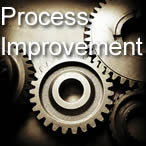20 Questions to Help You Improve Business Processes
Lean is a philosophy to continuously identify and eliminate waste within an organisation, where waste is defined as any activity that does not, from the customer’s perspective, add value. Fundamentally the Lean Philosophy is about continuous process improvement to create a business that optimally responds to customer demand.
While all business managers will recognise that the above statement is somewhat obvious, the real question is how does one actually go about improving processes?
Firstly, what are business processes? Business processes are ‘how we do things’, including, for example processing sales orders, drafting customer quotes or proposals, credit checking, generating a production schedule, placing purchase orders, generating invoices, creating reports, machining a component and assembling a product. Within any such process, there will always be an element of waste, where
“Waste is all Non-Value Added Effort, i.e. any activity that the Customer is not prepared to pay for…….but often has to!”
In order to improve any operational process and provide greater customer value, the process first needs to be understood, and the easiest way to understand a process is by drawing or mapping it. Mapping aims to create an end-to-end “picture” of the process…..A picture is worth a thousand words. Creating a visual picture of the process allows one to determine where customer value is being added, and then, by using the 20 Questions, identify the non-value added activities that may be reduced or eliminated to improve the process.
While there are many types of maps and charts, the simplest to use is Process Flow Chart that depicts the flow and interaction between tasks or operations, e.g. the customer order process at a local distribution company is shown below.

Once the process has been mapped and understood, areas of waste can usually be identified by asking one or more of the following 20 Questions, i.e.
20 Questions for Process Improvement
- Why are goods/documents being stored here?
- Why are the goods/documents etc being stored for such a long time?
- Why is this task necessary and why is it being done by this person/department?
- Can we re-arrange the physical layout of the department/office/factory/shop/surgery etc, to reduce the amount of movement and facilitate the flow of goods/information?
- Can we eliminate, simplify or combine this task with another?
- Is this task actually adding customer value or is it something “we have always done”?
- Why does this task take so long?
- What rules govern the process and completion status, and why?
- Can we group these people/departments/tasks together?
- Are we giving the customer what he really wants or only what is available, or perhaps even worse, what we have always provided?
- Is this report necessary, understood, and what is it used for?
- What metrics will allow us to improve the process or customer value?
- Why do these tasks result in scrap components or process errors?
- How can we reduce or eliminate variation, scrap rate or processing errors?
- Are we manually entering the same data in different systems and can we eliminate duplicated information by improved IT systems?
- Can we use new technology to improve the process or provide greater customer value?
- How can we improve the customer’s experience by reducing the time from order to delivery?
- When pressed for time, what steps in the process are skipped or worked around?
- Are we using accounting systems that require excessive time to produce management reports which may then result in poor decision making using ‘out-of-date’ information?
- Are costs being allocated in a manner that adds value to the decision making process?
The classic Deming PDCA improvement cycle is often used as powerful tool in conjunction with the 20 Questions to ensure all improvements are carried out in accordance with a well organised and defined methodology.

In Deming’s cycle, the Plan is not just about planning, but also includes communicating and gaining consensus. Far too often companies neglect this phase and fail to properly identify constraints and/or ‘root causes’ of problems. Do is the easy stage where the actual implementation is carried out, and this must be followed by the all-important Check phase. The Check is actually a learning phase where the prevailing question should be “is the change sustainable and did it work as we predicted, and if not, what can we learn for next time?” The final phase is the Act, where the emphasis is to standardise and communicate the improvement, prevent recurrence and to prepare for the next round of the cycle.
The PDCA sounds simple but it is often glossed over as many organisations concentrate on the ‘do’ and neglect the P-C-A, or alternatively adopt Murphy’s corollary to Deming’s PDCA cycle, i.e. “Please Don’t Change Anything”.
Process improvement is the essence of Lean, for without improvement, organisations will fail. Using the 20 Questions can assist in process improvement and guide an organisation along a path of continuous improvement.








